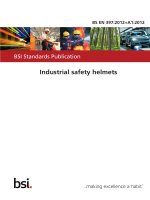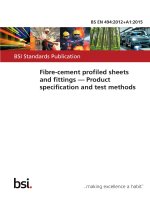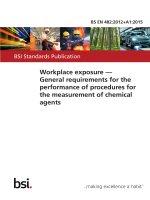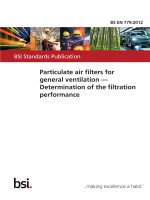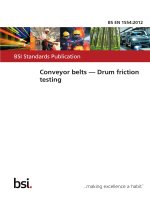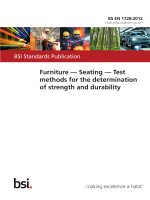Bsi bs en 61148 2012
Bạn đang xem bản rút gọn của tài liệu. Xem và tải ngay bản đầy đủ của tài liệu tại đây (1.12 MB, 30 trang )
BS EN 61148:2012
BSI Standards Publication
Terminal markings for
valve device stacks and
assemblies and for power
conversion equipment
BRITISH STANDARD
BS EN 61148:2012
National foreword
This British Standard is the UK implementation of EN 61148:2012.
It is identical to IEC 61148:2011.
The UK participation in its preparation was entrusted to Technical Committee
PEL/22, Power electronics.
A list of organizations represented on this committee can be obtained on
request to its secretary.
This publication does not purport to include all the necessary provisions of a
contract. Users are responsible for its correct application.
© The British Standards Institution 2012
ISBN 978 0 580 68664 1
ICS 29.200
Compliance with a British Standard cannot confer immunity
from legal obligations.
This British Standard was published under the authority of the
Standards Policy and Strategy Committee on 29 February 2012.
Amendments issued since publication
Amd. No.
Date
Text affected
BS EN 61148:2012
EUROPEAN STANDARD
EN 61148
NORME EUROPÉENNE
January 2012
EUROPÄISCHE NORM
ICS 29.200
English version
Terminal markings for valve device stacks and assemblies and for power
conversion equipment
(IEC 61148:2011)
Marquage des bornes de blocs et
d'ensembles d'éléments de valve et
d'équipement de conversion de puissance
(CEI 61148:2011)
Kennzeichnung der Anschlüsse von
Ventilbauelement-Baugruppen und sätzen sowie von Stromrichtergeräten
(IEC 61148:2011)
This European Standard was approved by CENELEC on 2011-11-24. CENELEC members are bound to comply
with the CEN/CENELEC Internal Regulations which stipulate the conditions for giving this European Standard
the status of a national standard without any alteration.
Up-to-date lists and bibliographical references concerning such national standards may be obtained on
application to the CEN-CENELEC Management Centre or to any CENELEC member.
This European Standard exists in three official versions (English, French, German). A version in any other
language made by translation under the responsibility of a CENELEC member into its own language and notified
to the CEN-CENELEC Management Centre has the same status as the official versions.
CENELEC members are the national electrotechnical committees of Austria, Belgium, Bulgaria, Croatia, Cyprus,
the Czech Republic, Denmark, Estonia, Finland, France, Germany, Greece, Hungary, Iceland, Ireland, Italy,
Latvia, Lithuania, Luxembourg, Malta, the Netherlands, Norway, Poland, Portugal, Romania, Slovakia, Slovenia,
Spain, Sweden, Switzerland, Turkey and the United Kingdom.
CENELEC
European Committee for Electrotechnical Standardization
Comité Européen de Normalisation Electrotechnique
Europäisches Komitee für Elektrotechnische Normung
Management Centre: Avenue Marnix 17, B - 1000 Brussels
© 2012 CENELEC -
All rights of exploitation in any form and by any means reserved worldwide for CENELEC members.
Ref. No. EN 61148:2012 E
BS EN 61148:2012
EN 61148:2012
Foreword
The text of document 22/185/FDIS, future edition 2 of IEC 61148, prepared by IEC/TC 22 "Power
electronic systems and equipment" was submitted to the IEC-CENELEC parallel vote and approved by
CENELEC as EN 61148:2012.
The following dates are fixed:
•
•
latest date by which the document has
to be implemented at national level by
publication of an identical national
standard or by endorsement
latest date by which the national
standards conflicting with the
document have to be withdrawn
(dop)
2012-08-24
(dow)
2014-11-24
Attention is drawn to the possibility that some of the elements of this document may be the subject of
patent rights. CENELEC [and/or CEN] shall not be held responsible for identifying any or all such patent
rights.
Endorsement notice
The text of the International Standard IEC 61148:2011 was approved by CENELEC as a European
Standard without any modification.
In the official version, for Bibliography, the following note has to be added for the standard indicated:
IEC 60445
NOTE Harmonized as EN 60445.
BS EN 61148:2012
EN 61148:2012
Annex ZA
(normative)
Normative references to international publications
with their corresponding European publications
The following referenced documents are indispensable for the application of this document. For dated
references, only the edition cited applies. For undated references, the latest edition of the referenced
document (including any amendments) applies.
NOTE When an international publication has been modified by common modifications, indicated by (mod), the relevant EN/HD
applies.
Publication
Year
Title
EN/HD
Year
IEC 60050-551
-
International Electrotechnical Vocabulary
(IEV) Part 551: Power electronics
-
-
IEC 60146-1-1
-
Semiconductor converters EN 60146-1-1
General requirements and line commutated
converters Part 1-1: Specification of basic requirements
-
BS EN 61148:2012
61148 © IEC:2011
CONTENTS
1
Scope . ............................................................................................................................................. 6
2
Normative references . .................................................................................................................. 6
3
Terms and definitions . .................................................................................................................. 6
4
Method of identifying terminals . .................................................................................................. 7
5
Terminal marking for valve device stacks and assemblies . .................................................... 8
5.1
6
Single and double way connections . ................................................................................ 8
5.1.1 General . .................................................................................................................. 8
5.1.2 Single way connections . ....................................................................................... 9
5.1.3 Double way connections . .................................................................................... 11
5.1.4 Combination of connections . .............................................................................. 13
5.2 Bi-directional connections . .............................................................................................. 14
5.2.1 Inseparable connections of pair of anti-parallel arms . ................................... 14
5.2.2 Combinations of pairs of anti-parallel arms . .................................................... 15
Marking of external main terminals of integrated conversion equipment . ........................... 18
6.1
A.C. terminals . .................................................................................................................. 18
6.1.1
6.1.2
6.1.3
6.2
Single-phase a.c. system .................................................................................... 18
Three-phase a.c. system .................................................................................... 18
A.C. conversion equipment with a.c. terminals on supply and load
side, for three-phase systems . ........................................................................... 18
D.C. terminals . .................................................................................................................. 19
6.2.1
6.2.2
6.2.3
6.2.4
6.2.5
6.2.6
6.2.7
6.3
General . ................................................................................................................ 19
A.C./D.C. conversion equipment . ...................................................................... 19
Double conversion equipment with reversible polarity of d.c.
terminals ............................................................................................................... 19
D.C. conversion equipment with d.c. terminals on the supply and load
sides . .................................................................................................................... 19
Terminal for connection to mid-wire conductor ................................................ 20
Conversion equipment with more than one converter section with
separate terminal sets on supply and load side. ............................................. 20
Conversion equipment in which the external main terminals are
formed by the main terminals of the assembly(ies) incorporated in the
equipment ............................................................................................................. 20
Marking of gate terminals . ............................................................................................... 22
6.3.1 General . ................................................................................................................ 22
6.3.2 For thyristors . ....................................................................................................... 22
6.3.3 For power transistors . ......................................................................................... 24
Figure 1 – Typical markings in single arm connections . .................................................................. 9
Figure 2 – Star connection with two arms . ...................................................................................... 10
Figure 3 – Star connection with three arms .................................................................................... 10
Figure 4 – Three groups with two arms . ......................................................................................... 11
Figure 5 – Two groups with three arms . ......................................................................................... 11
Figure 6 – Assembly for d.c. chopper . ............................................................................................. 11
Figure 7 – Pair of arms . .................................................................................................................... 12
Figure 8 – Bridge connection . .......................................................................................................... 12
BS EN 61148:2012
61148 © IEC:2011
Figure 9 – Double bridge connection . .............................................................................................. 13
Figure 10 – Anti-parallel bridge connection .................................................................................... 13
Figure 11 – Series connection of bridges . ...................................................................................... 14
Figure 12 – Fully controllable anti-parallel pairs . ........................................................................... 14
Figure 13 – Half-controllable anti-parallel pairs . ............................................................................ 14
Figure 14 – Example for six-phase supply . ..................................................................................... 15
Figure 15 – Three-phase star connection . ...................................................................................... 16
Figure 16 – Three-phase star connection with neutral .................................................................. 16
Figure 17 – Double two-phase star connection with neutral ......................................................... 16
Figure 18 – Polygon connection . ...................................................................................................... 16
Figure 19 – Legs for voltage stiff converters . ................................................................................ 17
Figure 20 – Bridge connection for voltage stiff converter (two-level) . ....................................... 17
Figure 21 – Three-level connection for inverter . ............................................................................ 18
Figure 22 – Single-phase a.c./d.c. converter . ................................................................................ 20
Figure 23 – Double converter . .......................................................................................................... 21
Figure 24 – Three-phase rectifier with two sections and d.c. side centre tap for
connection to a mid-wire conductor . ................................................................................................ 21
Figure 25 – Direct (or indirect) d.c. converter with two independent sections . ......................... 21
Figure 26 – Indirect (or direct) a.c. converter . ............................................................................... 22
Figure 27 – Three-phase star connection with neutral .................................................................. 23
Figure 28 – Bridge connection . ........................................................................................................ 23
Figure 29 – Thyristor with gate unit . ................................................................................................ 23
Figure 30 – Three-phase star connection with power transistors ................................................ 24
Figure 31 – Pair of power transistors with anti-parallel diodes . ................................................... 24
Figure 32 – Power transistor with gate driver . ............................................................................... 24
BS EN 61148:2012
–6–
61148 © IEC:2011
TERMINAL MARKINGS FOR VALVE DEVICE
STACKS AND ASSEMBLIES AND FOR
POWER CONVERSION EQUIPMENT
1
Scope
This International Standard is applicable to the terminal markings for the main circuits of valve
device stacks and assemblies, and of integrated conversion equipment. The terminal
markings refer to stacks, assemblies and equipment comprising semiconductor valve devices.
NOTE 1 Terminal markings for auxiliary circuits, including gate terminals and non-integrated conversion
equipment with separate manufacturing of its components and their interconnection only after installation on site,
are not considered in this standard.
For such equipment the relevant standards, if any, for the individual components apply.
Gate terminal markings are given in 6.3.
Terminal markings for other circuits such as protective conductor are not considered in this standard.
The object of this standard is to specify a logical alphanumeric marking system for the
identification of the external main terminals of the main power circuits in a stack, valve device
assembly or integrated conversion equipment, which is applicable for the purpose of
reference in circuit diagrams, catalogues, descriptions, and information exchange and storage.
In the case of stacks and assemblies, alphanumeric terminal marking systems are indicated
for those converter connections which are the most important and most commonly used ones.
Terminal marking systems making use of graphic symbols or identifying colours are not
considered in this standard.
NOTE 2
2
The terminals of auxiliary circuits should be marked such that they may be clearly identified.
Normative references
The following referenced documents are indispensable for the application of this document.
For dated references, only the edition cited applies. For undated references, the latest edition
of the referenced document (including any amendments) applies.
IEC 60050-551, International Electrotechnical Vocabulary – Part 551: Power electronics
IEC 60146-1-1, Semiconductor converters – General requirements and line commutated
converters – Part 1-1: Specification of basic requirements
3
Terms and definitions
For the purposes of this document, the terms and definitions given in IEC 60050-551,
IEC 60146-1-1 and the following apply.
3.1
external main terminals
terminals of the main power circuit of the stack, assembly or equipment to which the external
power supply or the load are connected
NOTE 1
In the following clauses this term is abbreviated to "terminals”.
BS EN 61148:2012
61148 © IEC:2011
NOTE 2
–7–
For stacks and assemblies the main power circuit is formed by the principal valve arms.
3.2
integrated conversion equipment
factory-built conversion equipment the components of which are assembled, interconnected
and tested in the factory thus forming a complete equipment
NOTE 1
Equipment composing one or more semiconductor switches is considered to be conversion equipment.
NOTE 2 For transport purpose, the equipment can be divided in several cubicles that will have to be reassembled
at the site.
3.3
anode
electrode capable of emitting positive charge carriers to and/or receiving negative charge
carriers from the medium of lower conductivity
[IEC 60050-151: 2001, 151-13-02]
NOTE 1 The direction of electric current is from the external circuit, through the anode, to the medium of lower
conductivity.
NOTE 2 In some cases (e.g. electrochemical cells), the term "anode" is applied to one or another electrode,
depending on the electric operating condition of the device. In other cases (e.g. electronic tubes and
semiconductor devices), the term "anode" is assigned to a specific electrode.
3.4
cathode
electrode capable of emitting negative charge carriers to and/or receiving positive charge
carriers from the medium of lower conductivity
[IEC 60050-151:2001, 151-13-03]
NOTE 1 The direction of electric current is from the medium of lower conductivity, through the cathode, to the
external circuit.
NOTE 2 In some cases (e.g. electrochemical cells), the term "cathode" is applied to one or another electrode,
depending on the electric operating condition of the device. In other cases (e.g. electronic tubes and
semiconductor devices), the term "cathode" is assigned to a specific electrode.
4
Method of identifying terminals
The use of alphanumeric notation should be preferred to any alternative marking, as in j).
a) The marking of the terminals should be based on alphanumeric notation employing capital
(upper case) roman characters and Arabic numerals.
NOTE 1 It is recommended that the reference letters for d.c. terminals are chosen from the first part and
reference letters for a.c. terminals from the second part of the alphabet.
NOTE 2 In those cases where difficulties could otherwise arise in correspondence, documents, etc., the use of
small (lower case) letters, which have the same significance, is permitted.
b) Letters “I” and “O” shall not be used to prevent confusion with the numerals “1” and “0”.
c) For converter connections with unchangeable polarity, “+” or “pos” may be used to the
positive terminal and “−” or “neg” may be used to the negative terminal.
NOTE 3
flow.
In this standard, if not otherwise stated, the term “polarity” is used with respect to the direction of current
d) The complete notation is based on the use of combinations of alternate alphabetical and
numerical character groups, each containing one or more letters and/or digits.
e) Terminals with identical basic markings according to Clause 5 and Clause 6 should be
distinguished by a reference number in a naturally ascending sequence according to the
sequence of operation or the direction of current flow starting with 1 and following the
basic terminal markings, for example X1 – X2 – X3, Y1 – Y2 – Y3.
BS EN 61148:2012
–8–
f)
61148 © IEC:2011
Terminals with identical basic markings according to Clause 5 and Clause 6 in two or more
similar terminal groups should be distinguished by a reference number in a naturally
ascending sequence starting with 1 and preceding the basic terminal markings, for
example 1X – 1Y – 1Z, 2X –2Y – 2Z, etc.
g) If, for further differentiation of terminal groups, further letters or numbers are required in
addition to the terminal marking in Clause 5 and Clause 6 and in f), such additional
marking should be placed before this marking, separated from it by a full stop.
h) The marking shall be clearly legible and durable.
i)
The marking of the main terminals according to Clause 5 to Clause 6 shall be shown
clearly on the corresponding circuit diagram. This shall also be observed for main and
auxiliary terminals not considered in this standard.
j)
In cases where the construction mode or size of a stack or assembly prevents the
application of the alphanumeric notation for terminal marking, the terminals shall be
clearly identified by another applicable method, for example by identifying colours or
graphic symbols which, however, are not the subject of this standard.
5
Terminal marking for valve device stacks and assemblies
5.1
Single and double way connections
5.1.1
General
The external main terminals of an individual principal arm or of a number of inter-connected
principal arms of the same polarity shall be marked by a capital letter corresponding to the
polarity of the end of the arm(s) connected to the terminal to be identified, also in cases
where the arms comprise, in addition to the valve devices, further components, for example
fuses, reactors, capacitors, etc.
The terminal for a common connection point of arms ending with the same polarity shall be
identified by the capital letter M placed behind the identification letter for its polarity.
–
End terminal of a principal arm forming:
•
an anode: basic terminal marking
A
•
a cathode: basic terminal marking
K
NOTE
arms.
–
Terminal for interconnection point of the anode of a principal arm with the cathode of a
second principal arm:
•
–
–
–
basic terminal marking
AK
Terminal for the interconnection point of two or more principal arms of the same polarity
forming:
•
an anode: basic terminal marking
AM
•
a cathode: basic terminal marking
KM
Terminal for an interconnection point of the same number of anodes and cathodes of
principal arms:
•
–
Although other markings may be used for valve devices, e.g. C and B or D and S, A and K are used for
basic terminal marking
AKM
If the valve device stack or assembly is used in a specific converter or semiconductor
switch, and its terminals are connected to terminals of the converter or switch, the terminal
marking of which may be used:
•
d.c. terminal: alternative terminal marking
C, D
•
a.c. terminal: alternative terminal marking
U, V, W
For converter connections with unchangeable polarity of the d.c. terminals the following
marking may be used alternatively:
BS EN 61148:2012
61148 â IEC:2011
9
ã
the sign + for the positive terminal
•
the sign − for the negative terminal
If several identical principal arms are combined to a connection in a single stack or assembly,
the end terminals with the same polarity shall be distinguished by natural reference numbers,
for example 1, 2, 3... placed behind the basic terminal markings, i.e. A1 – A2 – A3, K1 – K2 –
K3.
5.1.2
5.1.2.1
Single way connections
Single arm connection
Terminal marking:
–
Anode side:
A
–
Cathode side:
K
EXAMPLES: See Figure 1. Examples are shown for rectifier diode, P-gate reverse blocking
triode thyristor, PNP bipolar transistor, NPN bipolar transistor, N-channel IGBT and N-channel
Type C enhancement type MOSFET.
NOTE 1 The terminals of an individual principal arm which is intended to be part of a converter connection
comprising several principal arms may be marked like those of a single arm connection.
NOTE 2
The marking of terminals connected to auxiliary arms only is not considered in this standard.
NOTE 3 The arm which consists of several valve devices connected series and/or parallel is considered to be one
arm. The arm which consists of switched valve device and series diode for reverse blocking is also considered to
be one arm.
NOTE 4 In some kinds of controllable valve devices, rectifier diodes connected anti-parallel may be integrated in
common semiconductor chip or packaged in a common case. If the rectifier diodes are used, these arms are
considered as half-controllable anti-parallel pairs. See 5.2.1.
A
K
A
K
A
K
A
K
A
K
A
K
IEC
2087/11
Figure 1 – Typical markings in single arm connections
BS EN 61148:2012
– 10 –
5.1.2.2
61148 © IEC:2011
Centre tap and star connection
The m principal arms with one and the same polarity connected to a common point, forming
the d.c. terminal (m being a whole number equal to or greater than 2):
–
–
Cathodes forming the d.c. terminal:
•
Marking of individual arm terminals:
A1, A2 ... Am
•
Marking of common d.c. terminal:
KM
•
For diode rectifiers admissible:
+
Anodes forming the d.c. terminal:
•
Marking of individual arm terminals:
K1, K2 ... Km
•
Marking of common d.c. terminal:
AM
•
For diode rectifiers admissible:
−
EXAMPLES: See Figure 2 and Figure 3.
K1
AM
K2
IEC
2088/11
Figure 2 – Star connection with two arms
A1
A2
A3
KM
or +
IEC
2089/11
Figure 3 – Star connection with three arms
5.1.2.3
Several centre tap and star connections in a common assembly
A given number n of identical groups of m principal arms, all groups with the same polarity of
the d.c. terminals, for example n commutating groups with pulse number p, isolated from each
other, intended for interconnection via an external interphase transformer:
–
Cathodes forming the d.c. terminal:
•
Marking of individual arm terminals:
1A1 – 1A2 to 1Am
2A1 – 2A2 to 2Am
nA1 – nA2 to nAm
•
–
Marking of common d.c. terminal:
1KM to nKM
Anodes forming the d.c. terminal:
•
Marking of individual arm terminals:
1K1 – 1K2 to 1Km
2K1 – 2K2 to 2Km
nK1 – nK2 to nKm
•
Marking of common d.c. terminal:
EXAMPLES: See Figure 4 and Figure 5.
1AM to nAM
BS EN 61148:2012
61148 © IEC:2011
– 11 –
1K1 1K2
2K1 2K2
3K1 3K2
2AM
2–
3AM
3–
1AM
or: 1 –
IEC
2090/11
Figure 4 – Three groups with two arms
1KM
2KM
1A1 1A2 1A3
2A1 2A2 2A3
IEC
2091/11
Figure 5 – Two groups with three arms
5.1.2.4
Switched valve device arm and series connected reverse-direction diode arm
for d.c. chopper
This terminal marking is applied for choppers.
EXAMPLE:
See Figure 6.
K
A1
A2
D or −
IEC
IEC
2092/11
Figure 6a) – Regular terminal marking
5.1.3.1
Double way connections
Pair of arms
Terminal marking:
–
Central terminal:
AK
–
Anode side:
A
–
Cathode side:
K
EXAMPLE: See Figure 7.
2093/11
Figure 6b) – Alternative terminal marking
Figure 6 – Assembly for d.c. chopper
5.1.3
C2
or +2
C1
or +1
BS EN 61148:2012
– 12 –
61148 © IEC:2011
AK
A
K
IEC
2094/11
Figure 7 – Pair of arms
5.1.3.2
Bridge connection
m pairs of arms connected to a bridge connection.
Terminal marking:
–
Central terminals:
AK1 – AK3 to AKm
–
Anode side d.c. terminal:
AM
–
Cathode side d.c. terminal:
KM
–
For diode rectifiers admissible:
− for AM, + for KM
EXAMPLE: See Figure 8.
AK1 AK3 AK5
AM
or −
KM
or +
IEC
2095/11
Figure 8 – Bridge connection
NOTE 1
According to the conduction sequence of six diodes, 1, 3 and 5 are used as reference numbers.
NOTE 2 An open bridge connection with the positive bridge section isolated from the negative bridge section,
each section provided with separated a.c. terminals, can be considered as two centre tap or star connections. For
this connection mode the terminals of the two sections should be marked according to 5.1.2.2, e.g. A1 – A3 –
A5/KM and K4 – K6 – K2/AM.
5.1.3.3
Several bridge connections in a common assembly
The n bridge connections, isolated from each other.
Terminal marking:
–
Central terminals:
1AK1 – 1AK3 to 1AKm to
nAK1 – nAK3 to nAKm
–
Anode side d.c. terminals:
1AM to nAM
–
Cathode side d.c. terminals:
1KM to nKM
EXAMPLE: See Figure 9.
BS EN 61148:2012
61148 © IEC:2011
– 13 –
1KM
2KM
1AK1
2AK1
1AK3
2AK3
1AK5
2AK5
1AM
2AM
IEC
2096/11
Figure 9 – Double bridge connection
5.1.4
5.1.4.1
Combination of connections
Anti-parallel single way and double way connections
Terminal marking:
–
Centre tap and star connections:
•
–
Marking of common d.c. terminal:
AKM
Bridge connections:
•
Marking if common d.c. terminals:
AKM1 and AKM2
EXAMPLE: See Figure 10.
AKM1
1AK1
2AK1
1AK3
2AK3
1AK5
2AK5
AKM2
IEC
2097/11
Figure 10 – Anti-parallel bridge connection
5.1.4.2
Series connection of bridges
Intermediate terminal, if any (between the two bridges):
EXAMPLE: See Figure 11.
AKM
BS EN 61148:2012
– 14 –
1AK1 1AK3 1AK5
AKM
61148 © IEC:2011
2AK1 2AK3 2AK5
AM
KM
IEC
2098/11
Figure 11 – Series connection of bridges
5.2
Bi-directional connections
5.2.1
Inseparable connections of pair of anti-parallel arms
Terminal marking:
–
Fully controllable pairs:
End terminals marked by numbers 1 and 2 or AK1 and AK2.
EXAMPLE:
NOTE
–
See Figure 12.
Other connections having equivalent function are considered to be the pair of anti-parallel arms.
Half-controllable pairs:
For a pair of controllable valve device and anti-parallel diode, end terminals marked by A
and K according to the direction of the controllable valve device.
EXAMPLE:
See Figure 13.
1 or AK1
1 or AK1
1 or AK1
2 or AK2
2 or AK2
2 or AK2
IEC
2099/11
Figure 12 – Fully controllable anti-parallel pairs
A
A
A
K
K
K
IEC
Figure 13 – Half-controllable anti-parallel pairs
2100/11
BS EN 61148:2012
61148 © IEC:2011
5.2.2
– 15 –
Combinations of pairs of anti-parallel arms
The terminals of a combination of pairs of anti-parallel arms (in the following, abbreviated to
pairs of arms) are distinguished by the reference number:
–
1.1 / 1.2 to n.1 / n.2 or 1AK1 / 1AK2 to nAK1 / nAK2 for fully controllable n pairs of arms
–
1A / 1K to nA / nK, for half-controllable n pairs of arms
Pairs of arms which are intended to be connected directly or indirectly (via the load) to the a.c.
supply should basically be marked by the identifying letters:
–
U, V, for two pairs of arms
–
U, V, W, for three pairs of arms
and, if necessary, with the additional marking for the combinations of pairs of arms specified
in 5.2.2.1 and 5.2.2.2.
For more than three phases in the supply system:
Subdivision in two or more groups, with the terminals of each group marked by a reference
number preceding the basic terminal marking (see Clause 4, f)).
5.2.2.1
Isolated pairs of arms
Connected between the a.c. supply and the load.
–
Marking of supply side terminals:
U1 – V1 or U1 – V1 – W1
–
Marking of load side terminals:
U2 – V2 or U2 – V2 – W2
EXAMPLE: See Figure 14.
1U1
1V1
1W1
2U1
2V1
2W1
1U2
1V2
1W2
2U2
2V2
2W2
IEC
Figure 14 – Example for six-phase supply
5.2.2.2
Star connection
Marking of input terminals:
U, V, W
More than three pairs of arms: Same method as recommended in 5.2.2.1.
For star connections without neutral:
–
No further marking of neutral.
For star connections with neutral:
–
Marking of neutral terminal:
N
EXAMPLES: See Figure 15, Figure 16 and Figure 17.
2101/11
BS EN 61148:2012
– 16 –
61148 © IEC:2011
V
U
W
IEC
2102/11
Figure 15 – Three-phase star connection
U
V
W
IEC
N
2103/11
Figure 16 – Three-phase star connection with neutral
1U
1V
1N
2U
2V
2N
IEC
2104/11
Figure 17 – Double two-phase star connection with neutral
5.2.2.3
Polygon connection with m arms for m phases
Marking of input terminals:
U, V, W
with extension to 1U – 1V – 1W – 2U – 2V – 2W for example for six-phase polygon connection.
EXAMPLE: See Figure 18.
U
V
W
IEC
2105/11
Figure 18 – Polygon connection
5.2.2.4
Legs for voltage stiff converters
Terminal marking:
– Central terminal:
AK
– Anode side d.c. terminal of the controllable valve device:
A or +
– Cathode side d.c. terminal of the controllable valve device:
K or −
BS EN 61148:2012
61148 © IEC:2011
– 17 –
– D.C. mid-point terminal of three-level connection:
M
NOTE C for anode and D for cathode are also admissible.
EXAMPLE:
See Figure 19.
AK
AK
A
or +
K
or −
IEC
A
or +
K
or −
2106/11
IEC
M
Figure 19a) – For two-level converter
2107/11
Figure 19b) – For three-level converter
Figure 19 – Legs for voltage stiff converters
5.2.2.5
Bridge connection for voltage stiff converter
Terminal marking:
–
Central terminals:
AK1 to AKm
–
Anode side d.c. terminal of the controllable valve device:
AM or +
–
Cathode side d.c. terminal of the controllable valve device:
KM or −
–
D.C. mid-point terminal of three-level connection:
M
NOTE 1
Relations between AM and + and between KM and − are opposite to 5.1.3.2.
EXAMPLE:
See Figure 20.
AM
or +
AM
or +
AK1 or U
KM
or −
AK1 or U
AK3 or V
AK3 or V
AK5 or W
IEC
KM
or −
2108/11
IEC
Figure 20a) – Single phase connection for inverter
2109/11
Figure 20b) – Three phase connection
Figure 20 – Bridge connection for voltage stiff converter
(two-level)
NOTE 2
Terminal markings for d.c. and a.c. terminals are also admissible.
NOTE 3 When the single phase bridge connection is used as a four-quadrant chopper, terminal marking C1/D1 for
input terminal and C2/D2 for output terminal is admissible.
BS EN 61148:2012
– 18 –
5.2.2.6
61148 © IEC:2011
Three-level converter connection
Terminal marling is the same as above.
EXAMPLE: See Figure 21. A terminal marking C/D is applied according to 6.2.
C
or +
U
V
W
M
D
or −
IEC
2110/11
Figure 21 – Three-level connection for inverter
6
Marking of external main terminals of integrated conversion equipment
6.1
A.C. terminals
6.1.1
Single-phase a.c. system
Terminal marking:
–
without particular need to connect one terminal to the neutral conductor: U – V
–
with one terminal to be connected to the neutral conductor:
U–N
L1 – L2 or L1 – N may be applied instead of U – V or U – N.
NOTE These markings such as L1 or N are specified for line or neutral conductors by IEC 60445, and the same
terminal markings facilitate the connection to correct line conductors.
6.1.2
Three-phase a.c. system
Terminal marking:
–
without neutral terminal:
U–V–W
–
neutral terminal:
N
L1 – L2 – L3 may be applied instead of U – V – W.
6.1.3
A.C. conversion equipment with a.c. terminals on supply and load side, for
three-phase systems
Terminal marking:
BS EN 61148:2012
61148 © IEC:2011
–
supply side terminals:
– 19 –
U1 – V1 – W1 and
N1 if any
–
load side terminals:
U2 – V2 – W2 and
N2 if any
L1 – L2 – L3 may be applied for supply side instead of U1 – V1 – W1. In this case, U – V – W
for load side may be applied instead of U2 – V2 – W2.
In conversion equipment in which one and the same terminal set may form the supply (input)
side for one operation mode, or the load (output) side for a second operation mode, the
manufacturer should assign the preferred operation mode for the determination of the supply
and the load side, and should mark for this operation mode the corresponding terminal sets.
The corresponding marking method is equally applicable to single-phase a.c. systems and to
conversion equipment for single-phase a.c. systems.
6.2
D.C. terminals
6.2.1
General
Basic terminal marking:
C and D
For converter connections with unchangeable polarity of the d.c. terminals the following
marking may be used alternatively:
–
the sign + for the positive terminal
–
the sign − for the negative terminal
6.2.2
A.C./D.C. conversion equipment
Terminal marking:
–
positive terminal in rectifier operation:
C or +
–
negative terminal in rectifier operation:
D or −
6.2.3
Double conversion equipment with reversible polarity of d.c. terminals
Terminal marking:
C(D) and D(C)
The first letter corresponds to the polarity of the forward section, as assigned by the
manufacturer.
6.2.4
D.C. conversion equipment with d.c. terminals on the supply and load sides
Terminal marking:
–
supply side terminal set:
C1 – D1 or +1 – −1
–
load side terminal set:
C2 – D2 or +2 – −2
where C: positive terminals
D: negative terminals
In conversion equipment in which one and the same terminal set may form the supply (input)
side for one operation mode, or the load (output) side for a second operation mode, the
manufacturer should assign the preferred operation mode for the determination of the supply
and the load side, and should mark for this operation mode the corresponding terminal sets.
BS EN 61148:2012
– 20 –
61148 © IEC:2011
If the polarity is freely reversible such as in four-quadrant d.c. chopper, it is recommended to
use U and V in place of C(D) and D(C).
6.2.5
Terminal for connection to mid-wire conductor
Terminal marking:
6.2.6
M
Conversion equipment with more than one converter section with separate
terminal sets on supply and load side
Differentiation of identical basic terminal markings in the different groups by a reference
number preceding the basic terminal marking (see Clause 4 f)).
6.2.7
Conversion equipment in which the external main terminals are formed by the
main terminals of the assembly(ies) incorporated in the equipment
The terminal markings for the assembly(ies) according to Clause 5 may be used in place of
those specified in Clause 6.
EXAMPLES: See Figure 22, Figure 23, Figure 24, Figure 25 and Figure 26.
C or +
C
U
U
N or V
N or V
D
D or −
IEC
IEC
2111/11
Figure 22a) – Line commutated converter
2112/11
Figure 22b) – Voltage stiff self-commutated
converter
Figure 22 – Single-phase a.c./d.c. converter
BS EN 61148:2012
61148 © IEC:2011
– 21 –
C(D)
U
V
W
N
D(C)
IEC
2113/11
Figure 23 – Double converter
C or +
1U
1V
1W
M
2U
2V
2W
D or −
IEC
2114/11
Figure 24 – Three-phase rectifier with two sections and d.c. side centre tap
for connection to a mid-wire conductor
1C1
1C2
1D1
1D2
2C1
2C2
2D1
2D2
IEC
2115/11
Figure 25 – Direct (or indirect) d.c. converter with two independent sections
BS EN 61148:2012
– 22 –
61148 © IEC:2011
U1
U2
V1
V2
W1
W2
IEC
2116/11
Figure 26a) – Regular terminal marking
L1
U
L2
V
L3
W
IEC
2117/11
Figure 26b) – Alternative terminal marking
Figure 26 – Indirect (or direct) a.c. converter
6.3
Marking of gate terminals
6.3.1
General
If terminal markings for control terminals are necessary, next are applied.
–
control terminals of valve devices:
•
a gate terminal : basic terminal marking
G
•
the pair to the gate terminal : basic terminal marking
H
NOTE
–
Although markings B may be used for valve devices, G is used for valve device stacks and so on.
input terminals of gate transformers or gate drivers:
•
control signal input terminal:
E
•
control signal reference terminal:
F
•
shield terminal of the gate transformer (if any):
S
6.3.2
For thyristors
The same as 6.3.1.
EXAMPLES: See Figure 27, Figure 28 and Figure 29.
BS EN 61148:2012
61148 © IEC:2011
– 23 –
KM
K1
H1
H3
H5
G1
G3
G5
A1
A3
K3
K5
H1
H3
H5
G1
G3
G5
A5
AM
IEC
IEC
2119/11
2118/11
Figure 27a) – With common cathod
Figure 27b) – With common anode
NOTE Other reference numbers such as A1, A2 and A3 according to 5.1.2.2 or G4-H4, G6-H6 and G2-H2 are
permitted.
Figure 27 – Three-phase star connection with neutral
G1 H1
G3 H3
G5 H5
KM
AK1
AK3
AK5
AM
G4 H4
G6 H6
G2 H2
IEC
2120/11
NOTE Reference number G4-H4, G6-H6 and G2-H2 for KM side and G1-H1, G3-H3 and G5-H5 for AM side is
permitted.
Figure 28 – Bridge connection
A
A
E
E
F
F
S
K
IEC
Figure 29a) – With gate transformer
NOTE
S
K
IEC
2121/11
2122/11
Figure 29b) – With gate driver
In case of changing of a gate transformer the winding polarity shall be maintained.
Figure 29 – Thyristor with gate unit
